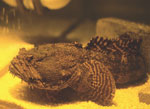 |

For further information, contact the MBL Communications Office at (508) 289-7423 or e-mail us at comm@mbl.edu
For Immediate Release: February 5, 2010
Contact: Diana Kenney, 508-289-7139; dkenney@mbl.edu
 |
 |
 |
Resources

The toadfish, Opsanus tau. Courtesy of S. Highstein. Click for full size.

A single hair cell from a frog ear magnified by a scanning electron microscope. Hair cells are essential sound and balance detectors in the inner ear. The study of these cells, which are a limited commodity and easily damaged in humans, is key to understanding hearing and balance loss. Image by Jason Meyers, Assistant Professor of Biology, Colgate University. Click for full size.
Citation:
Citation: Rabbitt, R.D., Boyle, B., and Highstein, S.M. (2010) Mechanical amplification by hair cells in the semicircular canals. PNAS Early Edition: Feb. 1-5 (doi/10.1073/ pnas0906765107).
Links:
|
Built-in Amps: Scientists Explore How Subtle Head Motions, Quiet Sounds are Reported to the Brain
MBL, WOODS HOLE, MA—The phrase “perk up your ears” made more sense last year after scientists discovered how the quietest sounds are amplified in the cochlea before being transmitted to the brain.
When a sound is barely audible, extremely sensitive inner-ear “hair cells”—which are neurons equipped with tiny, sensory hairs on their surface—pump up the sound by their very motion and mechanically amplify it. Richard Rabbitt of the University of Utah, a faculty member in the MBL’s Biology of the Inner Ear course, reported last spring on the magnification powers of the hair cell’s hairs.
Now, Rabbitt and MBL senior scientist Stephen Highstein have evidence that hair cells perform similarly in another context—in the vestibular system, which sends information about balance and spatial orientation to the brain.
“The bottom line is we have ‘accelerometers’ in the head that report on the direction of gravity and the motion of the head to the brain,” says Highstein. “What we found is they respond with a greater magnitude than expected for very small motions of the head. This brought to mind a similar amplification of very small signals by the human inner-ear cochlea. And, in fact, the vestibular system and the cochlea have a sensory element in common: the hair cells.” Rabbitt and Highstein found that, in both the auditory and the vestibular systems, the hair cell response exhibits “compressional nonlinearity”: The lower the strength of the stimulus, the more the hair cells “tune themselves up to amplify the stimulus,” Highstein says.
The toadfish was used for this study. “What’s interesting is the boney fishes evolved some 300 to 400 million years ago; subsequently this feature of its hair cells was apparently co-opted by the mammalian cochlea. Evolution conserved this feature, and the mammal later used it to improve hearing sensitivity,” Highstein says.
Highstein, who also teaches in the Biology of the Inner Ear course, joined the MBL resident staff last year, after being an MBL visiting investigator for 35 years. He was formerly a professor of otolaryngology at Washington University School of Medicine in St. Louis. Highstein’s research focuses on the vestibular system, in particular, “how the end organ constructs signals that go to the brain to report on the character and magnitude of head motion.” In essence, he says, “How does the inner ear do its job?”
This research was funded by the National Institute on Deafness and Other Communication Disorders.
The MBL is a leading international, independent, nonprofit institution dedicated to discovery and to improving the human condition through creative research and education in the biological, biomedical and environmental sciences. Founded in 1888 as the Marine Biological Laboratory, the MBL is the oldest private marine laboratory in the Americas. For more information, visit www.MBL.edu.
|